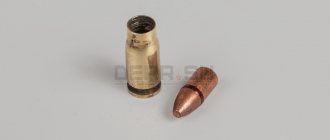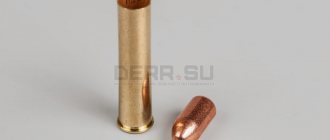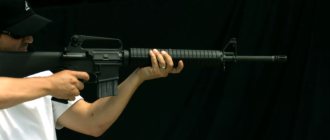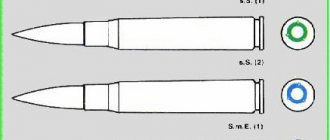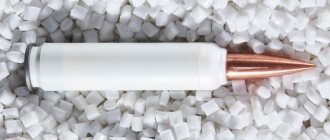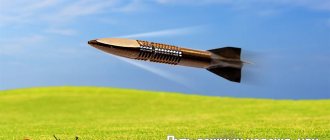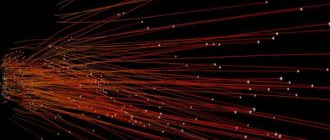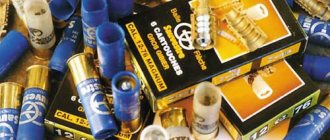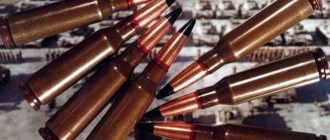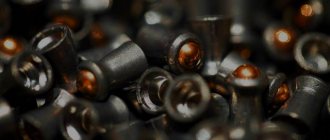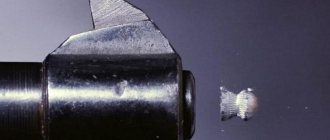The dimensions of each existing cartridge caliber are not specified in any order. Each caliber was initially designed to ensure that a particular cartridge had certain characteristics - usually with the goal of increasing its usefulness and effectiveness relative to existing ones. In addition, special cartridges have been developed and continue to be developed - tracer, silent and other types.
8x57 IS cartridges, which can be purchased using the services of our online store, have definitely earned their place in world history. You can learn about when and how this caliber was used, as well as its tactical and technical characteristics, right now.
How was the 8 57 cartridge used?
How was the 8 57 cartridge used? This cartridge was developed back in 1888, and subsequently it was used in all rifles and carbines produced by the German Empire and the Third Reich - Nazi Germany. It is for this reason that many Russian weapon connoisseurs strive to learn everything about the 8 57 Mauser cartridge. Its improved modifications (including the IS) were used both during the suppression of the so-called “Boxer Rebellion” in northern China, where Germany was an ally of the Russian Empire, and during the subsequent First and Second World Wars.
If you are interested in how the 8x57 cartridge works, then you should know its main distinguishing features. The case of the product has a bottle shape - in this case, the length reflected in the name of the caliber is measured from the bottom to the narrow end of the slope; The area forming the case muzzle is not taken into account in the calculations. The flange is separated from the case body by a shallow recess necessary for the ejector to operate, but its diameter does not exceed the actual diameter of the case.
Buying 8x57 IS cartridges means purchasing one of the latest modifications of this caliber, developed in 1905. This differs from previous cartridges in this line by a heavier bullet, having a larger actual diameter (8.22 millimeters) and a pointed end. This bullet design is characterized by better aerodynamics and less energy loss from the frictional force of the oncoming air flow - and therefore this 8 57 cartridge provides a greater effective firing range and accuracy than its predecessor with a rounded bullet.
Of course, this is not everything about the 8 57 Mauser cartridge that could be learned - however, posting accuracy tables and exact drawings here would be overkill. In our store you can find the 8×57 cartridge in the form of a set of original bullets and cartridge cases, which are necessary for assembling a full-fledged weight and size model of this product. We strongly recommend not to use these components for the manufacture of cartridges with the addition of a powder charge, since this is a criminal offense (Article 223 of the Criminal Code of the Russian Federation). At the same time, making an 8 57 cartridge without gunpowder for collection or reference is an absolutely legal action, since the training cartridge under the current jurisdiction cannot be used as ammunition for firearms.
Pre-war tee cartridge
Photo by the author
What then can we say about the 8x57R, in pre-reform times, the “standard” cartridge of a rifled barrel of German tees, the dream of any animal hunter, which came to Russia in the form of war trophies, or more modern ones, brought by officers who served in a group of Soviet troops in Germany.
Now cartridges of the specified caliber - a certain “rarity” - are in little demand. Firstly, the welt cartridge is more likely ammunition for a combination gun or rifle, a weapon compared to more expensive carbines. And if you consider that the choice of bullets for the specified calibers is very small, the “inattention” of hunters to the once popular calibers becomes understandable. But now, when there are many hunting grounds in which hunting (trophy) is strictly unregulated, a combined gun may be most suitable for both running hunts and shooting from ambush (storage, tower).
How can one not recall the words of the famous ornithologist, weapons expert and hunter S.A. Buturlina: “A tee or three-barreled shotgun completely replaces both a hunting double-barreled shotgun and a rifle (carbine) ... With a good tee, the hunter truly becomes the master of all living things.”
Personal experience of using the 8x57R cartridge in combined weapons on animal hunts generally left very favorable impressions. By chance, I managed to acquire a tee made by a little-known German master of excellent preservation and original layout. With a sneller that rises entirely when transferred to a rifled barrel, and most importantly, without the “irritating” “Greener” safety, which is so often found on German guns. Smooth barrels 16/1 gauge, indicating free drilling, 70mm chamber, Bellaire steel. A rifled barrel of Krupp steel, a caliber, most likely designated by the margins, 7.8x57. The craftsman did not provide any mounting space for the optical sight. Year of manufacture: 1938.
I'll make a small digression. When choosing an 8x57R cartridge, you should carefully study the gun marks (the presence of “S” caliber in the designation); this index indicates an increased bullet diameter - 8x57JRS. To avoid fatal mistakes, a corrugated ring is applied to the shell of the updated bullets, and the cartridge primer is coated with colored varnish. 8x57JRS cartridges fit perfectly into the chamber of a barrel made to 8x57JR dimensions (the cartridges are the same), but they cannot be fired. When fired, a bullet with an increased diameter will cause a sharp increase in the pressure of the powder gases and can rupture the relatively thin-walled bullet barrel of the tee.
There were great difficulties with ammunition in those years, and a box of cartridges left by hunters from Finland, from the RWS company, with 12.7 g T-Mantel semi-jacketed bullets, became the most valuable gift from our northern neighbors.
What can we say about T-Mantel (see table and description), a complete analogue of Alaska, from Norma. Speaking about this bullet, it should be noted that there is practically not a single cartridge in medium calibers where “Alaska” would not be in the assortment. “Alaska” is a classic flat-top bullet with a protruding lead core designed for shooting at short and medium distances. It quickly forms a “fungus”. Excellent stopping effect.
The first “test” of the cartridge took place on a driven elk hunt. Since at that time each cartridge was “worth its weight in gold,” I decided to do without zeroing, completely relying on the conscientiousness of the German craftsmen. The bull elk was shot at a close distance of about 40 meters on the sternum, walked about ten meters after the shot, no further retrieval was needed. The shot was so quiet that the huntsman did not hear it even at distant numbers and considered the drive a failure.
The first relatively long shot, approximately 150–180 meters, was also made at an elk. The decent-sized cow immediately lay down. I didn’t make any vertical adjustments; the bullet landed exactly in the right place. It deserves attention, not in terms of the accuracy of the shot, but in terms of the destruction caused by the bullet of the “weak” 8x57JR cartridge. The elk walked towards the number obliquely, the sight was on the front of the body. After the shot, from about 120 meters away, the elk, showing the agility of a hare, rushed back to the pen. He crashed into a pine tree, peeling off the skin on one side, and reached it. The bullet, having passed through the bones, was partially fragmented, but the destruction it caused was significant. Parts of the stomach were literally dragged into the lumbar spine area.
Of course, the 8x57JR may not have enough power to topple the beast. During the hunt for ungulates, this happened only once. Although the shot was at a wounded elk from a neighboring room (it turned out later), the elk walked smoothly, without blood or a hint of injury. A bullet from about a hundred meters literally knocked down a large bull. It should be taken into account that the wounded animal no longer experiences shock after the first hit. Apparently, even a “weak” cartridge, with an accurate hit, is enough to knock down a mighty beast.
Unexpectedly effective was a shot at a bear in the bait of a cow that had been run over by a clubfoot. The bullet, about forty paces away, hit just above the shoulder blade, passing obliquely through the chest. Most likely, he was lucky, after the shot the bear “behaved” so “quietly” that doubt crept in, maybe he was “hiding”. In any case, they stood for about five minutes with their guns at the ready, trying to see if their ears were flattened and their eyelids were moving.
I will limit myself here to a description of hunts and the action of the cartridge, since for many hunters who prefer hunting for “little things”, such “bloody” scenes will cause negative emotions. In conclusion, I dare to conclude that the 8x57JR cartridge, and even more so the 8x57JRS (which added about 20% in terms of “energy”), was “written off” by many hunters in vain. For most Russian hunting, the good old cartridge, especially in combination weapons, deserves more attention. And in fittings and byuksflints, welt cartridges will be “accepted” by the ejectors of these guns, whereas only extractors with a spring-loaded “butt” can “handle” a “carbine” cartridge with a “groove”. So the speed of replacing a cartridge with the “R” index in the corresponding guns is not only more convenient, but also faster.
Mikhail Galas September 27, 2013 at 00:00
Buy 8x57 IS cartridges at an affordable price
Here you can find collapsible 8x57 IS cartridges. Buying them at an affordable price is quite a big success, since at present this caliber is not actually used (not in service). In our store you can find a wide variety of components for assembling blank and training cartridges of almost any existing caliber - and the German Mauser rifle cartridge is no exception.
7.92mm cartridge (7.92x57) (8mm Mauser)
From the mid-1930s until the end of the war in 1945, cartridges produced in Germany, the countries it occupied, and those produced for Germany in other countries were usually marked with a non-segmented stamp arrangement: with four elements, rarely with two elements. The marking included a manufacturer's code intended to encrypt the plant. Until 1940, with few exceptions, this code consisted of the letter "P", often followed by two or three digits. Since 1941 this code was often replaced by an alphabetic code consisting of one, two or three letters. The markings on the bottom of the cartridge case use a 12 o'clock dial (like a watch) to make the marks easier to read. In the standard four-element marking, the manufacturer is located at 12 o'clock. The 3 o'clock code indicates the case material; “St” or “St+” indicate that the sleeve is steel, varnished or copper-plated. The combination of Roman numerals (from I to XXII) corresponds to the steel mill that supplied the shell metal; a capital letter indicates the plant that carried out the process of varnishing the shell, etc. Arabic numbers (1,2,3,6,15 or 17) indicate the grade of steel of the copper or brass coated sleeve (example: P181 Xw1 49 38). The marks “*” or “S*” indicate that the case is made entirely of brass. If there is a “\” between the manufacturer code and the case material code, then the case has only one primer hole at the primer. The batch number is indicated at 6 o'clock; the year of manufacture code, consisting of the last two digits, is located at 9 o'clock.
(1937 - 1941) Code with the letter "P"
| P14 | ? |
| P25 | ? |
| P28 | DeutscheWaffen-u. Munitionsfabrik AG, Werk Karlsruhe. G. Durlach |
| P34 | ? |
| P67 | H. Uttenörffer, Munitionsfabrik, Nuremberg |
| P69 | Sellier & Bellot, |
| P94 | Kabel-u. Metallwarenfabrik Neumeyer AG, Nuremberg |
| P120 | Dynamit AG, Werk Hannover-Empelde, |
| P128 | ? |
| P131 | DWMAG, Werk Berlin-Borsigwalde, Berlin |
| P132 | ? |
| P150 | ? |
| P151 | Rheinische-Westfälische Sprengstoff AG, Nuremberg |
| P152 | ? |
| P153 | ? |
| P154 | Polte Werke, Grünberg |
| P160 | ? |
| P162 | ? |
| P163 | ? |
| P181 | Hasag, Hugo Schneider AG, |
| P186 | ? |
| P198 | Metallwarenfabrik Treuenbritzen GmbH, Werk Belsig, Mark, |
| P207 | Metallwerke Odertal GmbH, Odertal |
| P224 | ? |
| P249 | Finower Industriewerk GmbH, Finow/Mark, |
| P265 | ? |
| P270 | ? |
| P315 | Märkisches Walzwerk GmbH, Strausberg |
| P316 | Westfälische Metallindustrie, Lippstadt, Westfalen, |
| P327 | ? |
| P334 | Mansfeld AG, Rothenburg an der Saale, Rothenburg |
| P340 | Metalwarenfabrik Silberhütte, St. Andreasberg, St. Andreasberg |
| P345 | ? |
| P346 | H. Huck, Metallwarenfabrik, Nürnberg W, Nuremberg |
| P369 | ? |
| P370 | ? |
| P379 | Scharfenberg-u.Teubert GmbH, Breitungen |
| P382 | ? |
| P397 | ? |
| P398 | ? |
| P405 | Dynamit AG, Durlach |
| P413 | ? |
| P414 | ? |
| P417 | ? |
| P442 | ? |
| P457 | ? |
| P490 | ? |
| P491 | ? |
| P635 | Munitionsfabrik Wöllersdorf, Wien |
| P757 | ? |
Manufacturer codes
| a | Aug.d.Haer, Metallwerke, Troisdorf, Troisdorf |
| b | Sundwiger Messingwerke, Sundwig Kreis Iserlohn |
| c | Vereinigte Deutsche Nickelwerke AG, Schwerte (Ruhr), Ruhr |
| d | Vereinigte Deutsche Nickelwerke AG, Werk Laband |
| e | Trierer Walzwerk AG, Werk Burg bezirk Magdeburg, Magdeburg |
| f | Mansfeld AG, für Bergbau und Hüttenbetrieb, Finow (Mark), |
| g | Hirsch Kupfer u. Messingwerke AG, Zentrale Berlin, Berlin |
| h | Wielandwerke AG, Metallhalbfabrikate, Ulm (Donau) |
| j | R.und G. Schmöle Metallwerke, Menden (Westfalen), |
| l | Dürener Metallwerke AG, Werk Metallhalbfabrikate Düren, Düren (Rheinland) |
| m | FA Lange Neusilberfabrikate AG, Aue (Sachsen) |
| n | Westfälische Kupfer-u. Messingwerke AG, vorm. Caspar Noell, Lüdenscheid (Westfalen) |
| o | Eduard Hueck Metallwarenfabrik, Lüdenscheid (Westfalen) |
| p | Stollberger Metallwerke KG (von Asten, Lynen-u. Schleicher), Stolberg (Rheinland) |
| q | Wilhelm Prym Metallfabrikate, Stollberg (Rheinland) |
| r | Deutsche Messingwerke Carl Eveking AG, Metallhalbfabrikate, Berlin-Niederschönnwalde, Berlin |
| s | Dynamit AG, vorm. Alfred Nobel-u. Co. Werk Skt Lambrecht |
| t | Dürener Metallwerke AG, Berlin-Borsigwalde, Berlin |
| u | Osnabrücker Kupfer- u. Drahtwerke AG, Osnabrück |
| v | Kabel-u. Metallwerke Neumeyer AG, Nuremberg |
| w | Hugo Schneider AG Messingwerke, Taucha-Leipzig, |
| x | Busch-u. Jäger Lüdenscheider Metallwerke AG, Lüdenscheid |
| y | Sächsiche Metallwarenfabrik Aug.Wellner u. Sohn AG, Aue, (Sachsen) |
| z | Kupferwerk Ilsenburg AG, Ilsenburg (Harz) |
| ac | Vereinigte Deutsche Nickelwerke AG, Schwerte (Ruhr), Ruhr |
| ba | Sundwiger Messingwerke, Sundwig Kreis Iserlohn |
| bb | A. Laue und Co, Berlin Reinickendorf, Berlin |
| bc | Kupfer-u. Messingwerke AG, Becker-u. Co., Langenberg (Rheinland) |
| bd | FA Lange Metallwerk AG, Bodenbach (Sudeten) |
| be | Berndorfer Metallwarenfabrik Arthur Krupp, Berndorf (Niederdonau) |
| dm | Deutshe Waffen und Minitionsfabriken, Karlsruhe |
| ca | Vereinigte Deutsche Nickelwerke AG, Schwerte (Ruhr) (1941), Ruhr |
| eh | Trierer Walzwerke AG, Werk Burg bezirk Magdeburg, Magdeburg |
| fa | Mansfeld AG für Bergbau und Hüttenbetrieb, Hettstedt (Harz) |
| ga | Hirsch Kupfer-u. Messingwerke AG, Finow (Mark), |
| ma | FA Lange Neusilberfabrikate AG, Aue (Sachsen) |
| mw | Munitionswerke, Shoenebeck |
| na | Westfälische Kupfer-u. Messingwerke AG, vorm. Caspar Noell, Lüdenscheid (Westfalen) |
| pm | Polte Armaturen und Mashinenfabrik AG, Magdeburg |
| un | Utendoerffer, H, Nuremberg |
| ra | Deutsche Messingwerke Carl Eveking AG Metallhalbfabrikate, Berlin-Niederschönwalde., Berlin |
(1941 - 1945) Manufacturer codes
| ad | Patronen-, Zündhütchen-u. Metallwarenfabrik AG, Schönebeck an der Elbe |
| ak | Munitionsfabriken vormals Sellier und Bellot, Werk Vlasim, Prag |
| am | Gustloff Werke, Otto Eberhardt Patronenfabrik, Hirtenberg, Niederdonau |
| asb | Deutsche Waffen-u. Munitionsfabriken AG (DWM), Berlin-Borsigwalde, Eichborndamm |
| aux | Polte-Werke, Werk Magdeburg |
| auy | Polte-Werke, Werk Grüneberg |
| avu | Silva Metallwerke GmbH, Werk Genthin |
| bne | Metallwerke Odertal GmbH, Odertal Post Lautaberg/Harz |
| cg | Finower Industrie GmbH, Finow/Mark |
| ch | Fabrique Nationale d'armes de guerre SA, Herstal/Liège, Belgique |
| dnf | Rheinisch-Westfälische Sprengstoff AG, Werk Stadeln bei Nürnberg |
| dom | Westfälische Metall-Industrie AG, Lippstadt, Westfalen |
| dot | Waffenwerke Brünn AG, Werk Brünn |
| dou | Waffenwerke Brünn AG, Werk Povaszka Bystrica |
| eba | Scharfenberg & Teubert GmbH, Metallwarenfabrik, Breitungen-Werra |
| edq | Deutsche Waffen-u. Munitionsfabriken AG, Lübeck-Schlutup |
| eej | Markisches Walzwerk GmbH, Straussberg Bezirk Potsdam |
| eey | Metallwarenfabrik Treuenbritzen GmbH, Werk Roederhof |
| emp | Dynamit AG vormals Alfred Nobel & Co, Werk Empelde bei Hannover |
| eom | H. Huck Metallwarenfabrik, Nürnberg W |
| fb | Mansfeld AG, Rothenburg/Saale |
| fer | Metallwerke Wandhofen GmbH, Schwerte/Ruhr |
| fva | Draht-u. Metallwarenfabrik GmbH, Salzwedel |
| hhw | Metallwerke Silberhütte GmbH, St-Andreasberg im Harz |
| hla | Metallwarenfabrik Treuenbritzen GmbH, Werk Sebaldushof |
| hlb | Metallwarenfabrik Treuenbritzen GmbH, Werk Selterhof |
| hlc | Zieh-u. Stanzwerke GmbH, Schleusingen, Thüringen |
| hrn | Presswerke GmbH, Metgethen, Ostpreussen |
| kam | Hugo Schneider AG, Werk Skarzysko Kamienna, Polen |
| nbe | Hasag, Eisen-u. Metallwerke GmbH, Werk Apparatebau, Tschenstochau |
| oxo | Teuto-Metallwerke GmbH, Osnabrück |
| va | Kabel-u. Metallwerke Neumeyer AG, Nürnberg |
| wa | Hasag, Hugo Schneider AG Abteilung Lampenfabrik, Leipzig 05 |
| wb | Hasag, Hugo Schneider AG, Werk Berlin-Köpenick |
| wg | Hasag, Hugo Schneider AG, Werk Altenburg, Thüringen |
Chuck type identification
Due to a shortage of lead in Germany, the production of 7.92mm bullets with a steel core was established. Such bullets were designated: SmE (Spitzgeschoss mit Eisenkern) and SmE lg (Sptizgeschoss mit Eisenkern, long). There was a layer of lead between the core and the jacket of the SmE bullet to facilitate deformation of the bullet body as it passed along the rifling of the bore. The SmE lg bullet had a longer core than the SmE bullet. The bullet casing was covered with a thin layer of brass or zinc.
The steel sleeves were coated with varnish and a thin layer of lubricant to protect against corrosion and improve extraction. Copper-plated steel sleeves were produced in large quantities. Copper-plated cases were marked with Roman numerals, while lacquered cases were marked "St" or "St+". The walls of cases marked "St" were thicker than those of brass cases. Cases marked “St+” had the same wall thickness as brass cases.
The cartridges were marked with a color code according to their purpose.
Several conventional types of cartridges were produced in the "verbessert" (improved) version, distinguished by the charge of reinforced gunpowder. These cartridges are designed for use in aircraft machine guns; the bullets have increased velocity and higher pressure develops in the bore than when using conventional cartridges. Such cartridges are not recommended for use in rifle shooting.
Cartridges intended for use in tropical conditions have a strip of varnish on the muzzle of the case where the bullet is attached in the same color as the inscription “trop” on the primer and on the cartridge packaging.
sS Patrone: (Schweres Spitzgeschoss): Heavy bullet. SmE: (Spitzgeschoss mit Eisenkern): Bullet with a steel core. SmElg. : (Spitzgeschoss mit Eisenkern, lang) : Bullet with a steel core, long. lS : (Leichtes Spitzgeschoss) : Light bullet. lSL'Spur : (Leichtes Spitzgeschoss mit Leuchtspur) : Lightweight tracer bullet. sS Beschuss Patrone: (Schweres Spitzgeschoss Beschuss): Heavy bullet, high pressure test cartridge. N Patrone: (Nahpatrone): Subsonic cartridge, for use with PBS. sS 30/40 : (Schweres Spitzgeschoss 30/40) : Heavy bullet 30/40. For use in severe frosts (-40°C). SmK : (Sptizgeschoss mit Stahlkern) : Armor-piercing bullet. SmKH: (Sptizgeschoss mit Stahlkern, gehartet): Bullet with a hardened core. SmKL'Spur: (Spitzgeschoss mit Stahlkern und Leuchtspur): Tracer bullet with a hardened core. SmKGl'Spur: (Sptizgeschoss mit Stahlkern und Glimmspur): Night (for shooting at night) tracer bullet with a hardened core. SmK Ub.m.Zerl. : (Sptizgeschoss mit Stahlkern Ubungsmunition mit Zerleger) : Practical light bullet with a steel core and self-destructive device. SmKL'Spur Ub.m.Zerl. : (Sptizgeschoss mit Stahlkern und Leuchtspur, Ubungsmunition mit Zerleger) : Practical light tracer bullet with a steel core and self-destructor. PZ Patrone: (Panzer Patrone): Bullet with a heavy steel core.
- Pr. : (Sptizgeschoss mit Phosphor) : Light incendiary bullet.
PmK : (Phosphor mit kern) : Armor-piercing incendiary bullet. B Patrone: (Beobachtung Patrone): Targeting bullet (actually explosive-incendiary). SmK-v. : (Sptizgeschoss mit Stahlkern, verbessert) : Steel core bullet, improved. SmKL'Spur-v. : (Sptizgeschoss mit Stahlkern und Leuchtspur, verbessert) : Improved steel core tracer bullet. SmKGl'Spur-v. : (Sptizgeschoss mit Stahlkern und Glimmspur, verbessert): Night tracer bullet with steel core, improved. PmK-v. : (Phosphor mit Kern, verbessert) : Lightweight incendiary bullet with a steel core, improved. B Patrone-v. : (Beobachtung Patrone, verbessert): Targeting bullet, improved. sS-Trop. : (Schweres Sptizgeschoss-Tropen) : Heavy bullet for the tropics. SmK-Trop. : (Sptizgeschoss mit Stahlkern-Tropen) : Steel core bullet, for the tropics. SmKL'Spur-Trop. : (Sptizgeschoss mit Stahlkern und Leuchtspur-Tropen) : Tracer bullet with steel core, for the tropics. SmKGl'Spur-Trop. : (Spitzgeschoss mit Stahlkern und Glimmspur-Tropen) : Night tracer bullet with steel core, for the tropics.
PmK-Trop. : (Phosphor mit Stahlkern-Tropen) : Incendiary bullet with steel core, for the tropics.
B-Trop. : (Beobachtung-Tropen): Targeting bullet, for the tropics.
SmK-v.-Trop. : (Sptizgeschoss mit Stahlkern, verbessert-Tropen) : Steel core bullet, improved, for the tropics.
SmKL'Spur-v.-Trop. : (Sptizgeschoss mit Stahlkern und Leuchtspur, verbessert-Tropen) : Steel core tracer bullet, improved, for the tropics.
SmKGl'Spur-v.-Trop. : (Sptizgeschoss mit Stahlkern und Glimmspur, verbessert-Tropen) : Night tracer bullet with steel core, improved, for the tropics.
PmK-v.-Trop. : (Phosphor mit Stahlkern, verbessert-Tropen) : Steel-core incendiary bullet, improved, for the tropics.
Bv.-Trop. : (Beobachtung, verbessert-Tropen) : Targeting bullet, improved, for the tropics.
sS Patrone (1940); 8. SmK; 9. SmKL'Spur
PmK ; 11. B. Patrone; 12. SmKL'Spur-Trop.
SmK-v. ; 14. SmK-h. ; 15. PZ Patrone
SmK Ub.m.Zerl. ; 17.LS; 18. LSL'Spur
Sme ; 20. SmElg. ; 21. Duplex Patrone
Ex. Patrone S(K); 23. Platz Patrone 33 (training)
Package
The cartridges are packaged in cardboard boxes with a label indicating the contents. The color of the label indicates the type of cartridge.
For 7.92 x 57 cartridges:
- -white: simple and armor-piercing cartridges
- -yellow: tracer cartridges
- -green: armor-piercing incendiary cartridges
- -white and black on top - explosive cartridges
- -white with vertical green stripe - lightweight, practical tracer cartridges
- -separated by red and white diagonals - armor-piercing with a reinforced core
- - red - blank cartridges.
Labels
- -first line: bullet type (example: sS, SmK, ...) track color (example: gelg, orange, ...), for the tropics: Trop.
- -second line: plant code, batch number and date (example: P120 5. L. 40).
- -third line: type of gunpowder (example: Nz. Gew. BI. P. - nitrocellulose rifle flake powder), name or code of its manufacturer, date.
- -fourth line: sleeve type (example: *, S*, St, St+), indication of the sleeve manufacturer, batch number and date.
- -fifth line: bullet manufacturer, batch number, date.
- -sixth line: tracer composition manufacturer code, capsule type and its manufacturer (example: Zdh 88 SKD or Zdh 30/40), batch number, date.
The overprint indicates the type of packaging and what weapons the cartridges are intended for or are prohibited:
-iL or In Ladenstreifen: cartridges in clips.
-ohne Ladestreifen: cartridges without clips.
-Für Gewehr or Für MG: this batch is specifically for rifles or machine guns.
-Unbekannts or Lieferung Unbekannts: mixed cartridges of unknown manufacturer.
Most often, twenty boxes of 15 rounds each were packed in intermediate boxes or metal zinc. Five such boxes (zinc) were packed in a wooden box with the appropriate label. The batch consisted of 1020 boxes.
If you find an error or typo, please select a piece of text and press Ctrl+Enter.
0 0 votes
Article rating
